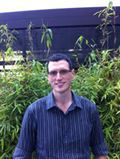
 Professor Jason Hein was lured to UC Merced because of the opportunity to pursue his research, even if it crosses into other branches of chemistry, physics, biology and engineering.
Professor Jason Hein was lured to UC Merced because of the opportunity to pursue his research, even if it crosses into other branches of chemistry, physics, biology and engineering.
“Being a jack of all trades is quite an asset at a new campus,” Hein said. “It’s an advantage, not a disadvantage.”
Hein spent five years at the Scripps Research Institute as a postdoctoral researcher and senior research associate before coming to UC Merced. He received his bachelor’s and doctoral degree from the University of Manitoba in Canada.
He studies reaction kinetics, which means he’s more concerned with understanding what happens during a chemical reaction than just the end result.
“I care about the journey a reaction takes, not just the destination,” Hein said. “My research has focused on making a mess and then sorting it out.”
Using this approach has led to some very interesting and unusual results. While at Scripps, Hein worked with a team that discovered a relatively simple combination of naturally occurring sugars and amino acids that, when combined, offers a plausible route to the building blocks of life.
Biological molecules, such as RNA and proteins, can exist in either a natural or unnatural form, called enantiomers. By studying the chemical reactions carefully, the research team found that it was possible to generate only the natural form of the necessary RNA precursors by including simple amino acids. The paper reporting these findings was recently published in “Nature Chemistry.”
“These amino acids changed how the reactions work and allowed only the naturally occurring RNA precursors to be generated in a stable form,” said Hein. “In the end, we showed that an amazingly simple result emerged from some very complex and interconnected chemistry.”
At UC Merced, Hein will put these skills to work in a diverse research program focused on designing new catalysts, which will help make new pharmaceuticals and develop sustainable chemical manufacturing processes. Hein said he looks forward to making a difference at UC Merced as it continues to hire more faculty members and develop academic programs.
“You’re part of a university during a really big growth phase,” Hein said.






